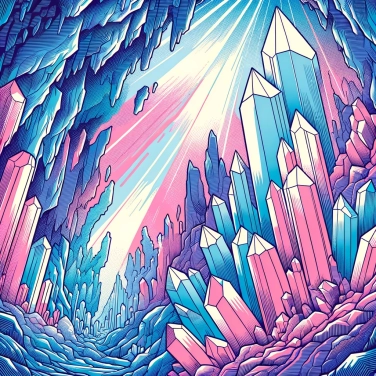Giant crystals in caves are formed thanks to complex geological processes involving the saturation of water in minerals, favorable temperature and pressure conditions, and a long period of time for crystal growth.

These giant crystals often come into being thanks to the circulation of mineral-saturated fluids in caves located near volcanic or hydrothermal sources. Typically, magma located beneath the Earth's crust heats large amounts of groundwater laden with dissolved chemical elements, then pushes it upward toward the surface through rock fissures. During their ascent, these fluids cool slowly in underground cavities, gradually triggering the crystallization of dissolved minerals. This slow cooling and the very stable conditions of the environment allow crystals to form slowly but surely. Thus, with a great deal of time and good conditions, some caves can become adorned with impressive giant crystals.
To have giant crystals, several things must come together: first, a stable temperature is needed, neither too hot nor too cold, often around fifty degrees Celsius. A very high humidity is also required; in other words, the cave must be full of water or have aquifers filled with dissolved minerals. If this water is rich in minerals like gypsum, it greatly aids in the formation of impressive crystals. One last key detail, the pressure must remain stable for thousands, even millions of years: the more constant it is, and the fewer external disturbances there are, the more time the crystals will have to grow quietly and reach spectacular sizes.
The formation of giant crystals is a matter of chemistry in action. First, you need water rich in dissolved minerals, often gypsum, composed of calcium and sulfate. When the water slowly seeps underground, it is heated by the proximity of a magma pocket, which increases its ability to dissolve these minerals. Once this water is brimming with minerals, it remains for a long time in underground cavities. There, the conditions change slowly: the temperature decreases, the water begins to cool down gradually and slowly loses its ability to retain as many minerals. The result? These minerals gradually precipitate and settle little by little, forming crystals, which grow in size over time. This constant slowness is crucial: it allows the crystals to develop in a regular manner, without disruption, sometimes becoming extraordinarily large, up to several meters long.
The Naica Cave in Mexico is undoubtedly one of the most famous caves with giant crystals: it contains gypsum crystals that can reach over 11 meters in length and weigh several tons. In Spain, the Pulpí Cave also features spectacular crystals, including geodes filled with transparent crystals that can measure several meters. Another well-known example is the Crystal Mine located in the state of Chihuahua, Mexico, where giant selenite crystals impress with their size and purity. These caves provide unique conditions that allow crystals to grow for a very long time, thus reaching remarkable sizes.
Giant crystals do not grow quickly: their size directly depends on the factor of time. The longer they have an uninterrupted growth period, the more likely they are to reach impressive dimensions. The stability of the environment is just as essential, as even the slightest variation in temperature, pressure, or chemical composition can slow down or even completely halt their development. In short, in geology, it's simple: the calmer and more stable the environment is for a long time, the more the crystals can grow peacefully until they become monumental.
The growth rate of giant crystals is extremely slow, sometimes only a few millimeters per century, requiring tens of thousands of years to reach exceptional sizes.
Giant crystals are generally composed of gypsum, a transparent mineral primarily made up of water and calcium sulfate, requiring specific conditions of humidity and temperature to form.
Caves containing giant crystals are often extreme environments with very high temperatures and humidity levels approaching 100%, making their exploration particularly difficult.
The term 'crystal' derives from the ancient Greek 'krystallos,' which meant 'clear ice,' as the first observed crystals were likely transparent quartz resembling ice.
The formation of a giant crystal can take thousands, or even hundreds of thousands, of years. Their slow and steady growth primarily depends on the prolonged stability of geological and environmental conditions. The particularly slow growth explains the exceptional size reached by some crystals.
To preserve the integrity of fragile crystals and ensure the safety of visitors, caves containing giant crystals, such as the Naica cave in Mexico, are generally not open to the public. However, some caves are accessible for guided tours, but they often contain crystals that are somewhat smaller in size.
Giant crystals, such as those made of gypsum (selenite), are often translucent or transparent because they form through an extremely slow process that allows for a perfectly ordered arrangement of molecules, minimizing imperfections and impurities. This molecular purity results in a characteristic translucent or transparent appearance.
Yes, the relocation or extraction of giant crystals poses a high risk due to their fragility, immense weight, and the sudden change in climatic conditions (temperature, humidity) that can lead to their crumbling or breaking. Furthermore, extracting the crystals could disrupt the fragile chemical and geological balance of these exceptional underground environments.
The Naica Cave in Mexico is particularly famous for its giant gypsum crystals, which can reach lengths of up to 11 meters and weigh as much as 55 tons. The Cave of Swords, also located in Naica, is known for its beautiful smaller crystals that are spectacular in their shape.

0% of respondents passed this quiz completely!
Question 1/5